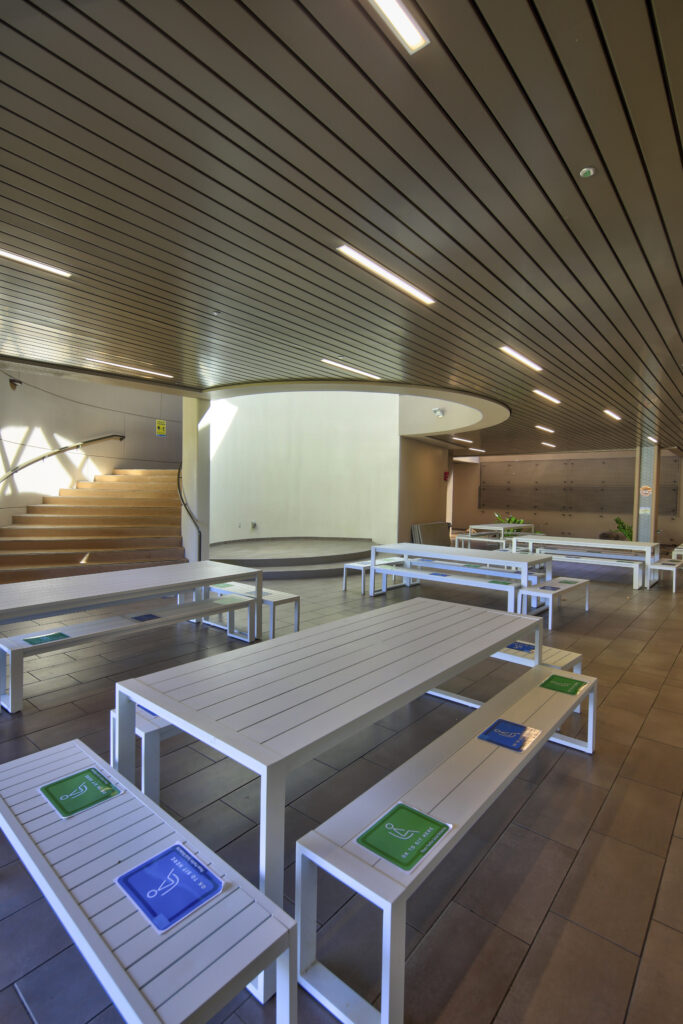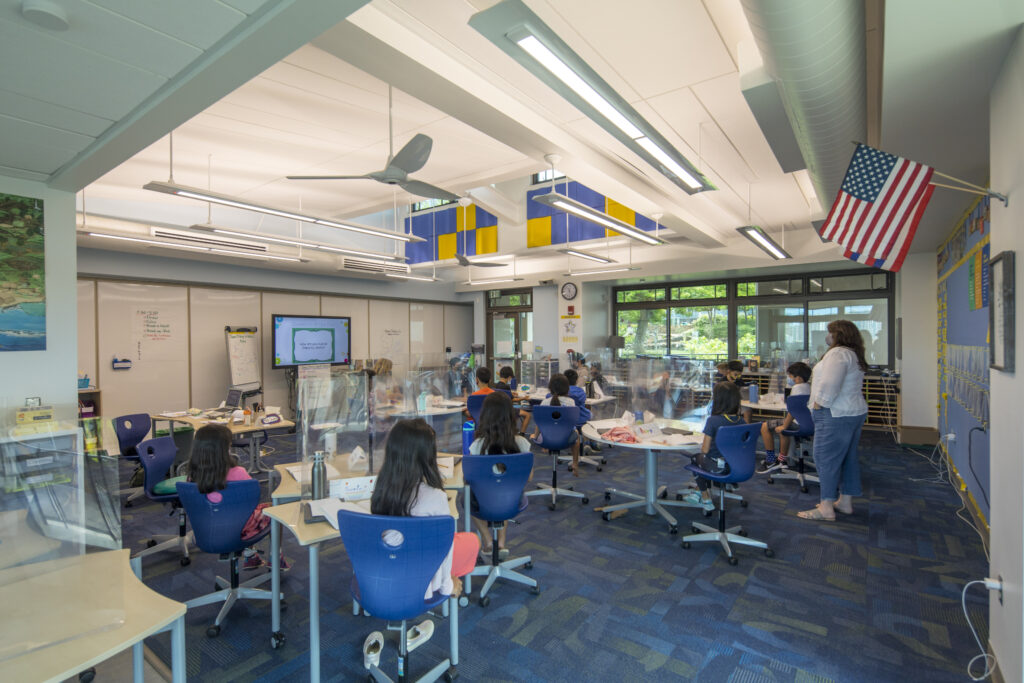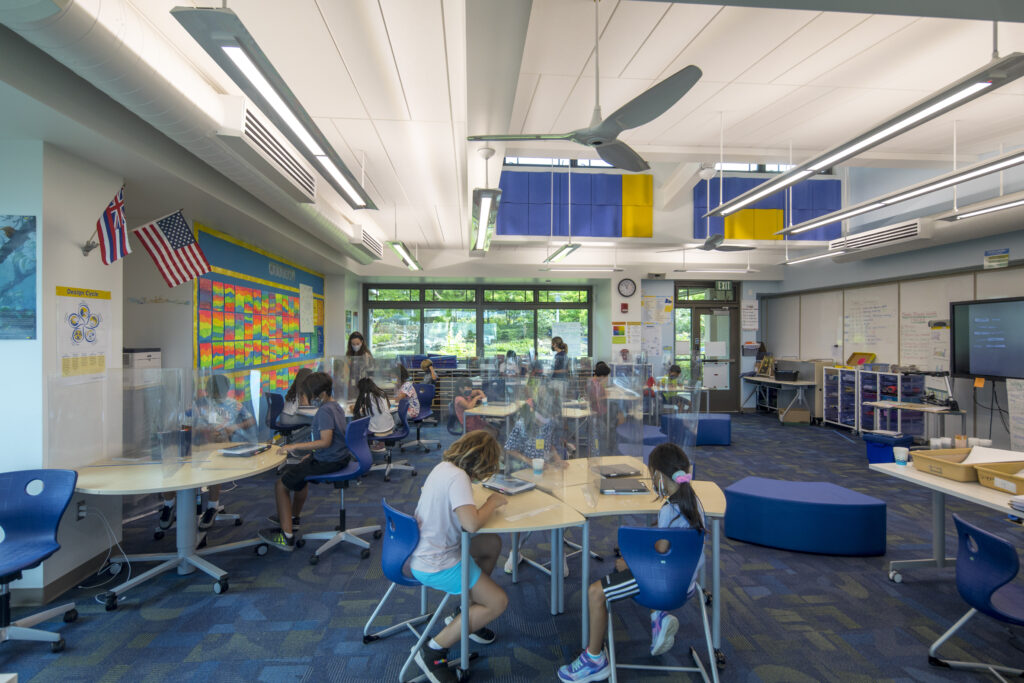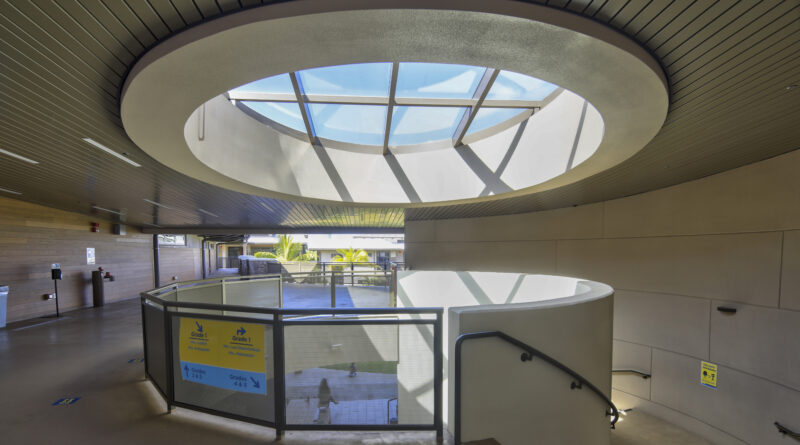Punahou School
Sustainable & Aesthetic Learning Campus in Honolulu, Hawaii
by Heather West, president, Heather West Public Relations
Collaborating with Punahou School’s faculty, Design Partners, Honolulu, Hawaii, envisioned The Sidney and Minnie Kosasa Community in Honolulu as a state-of-the-art learning environment with a focus on sustainability. The first net-zero energy facility on the 180-year-old private campus, Kosasa Community meets Hawaii’s Collaborative for High Performance Schools (HI-CHPS) Criteria™ as a Verified Leader, and is pursuing International Living Future Institute’s Living Building Challenge (LBC) Net Zero and United States Green Building Council’s LEED® for Schools Platinum certification.

Home to more than 3,750 kindergarten through 12th-grade students, many of Punahou School’s graduates have become leaders of industry, culture, and innovation, including President Barack Obama. Within the 76-acre campus, Kosasa Community features two new educational neighborhoods serving students in grades two through five. Design Partners specified a variety of Rockfon® acoustic stone wool and metal ceiling systems to enhance the different learning spaces and their aesthetic, performance, and sustainable goals.
Space to Learn & Grow
“This community is inspired by the latest research in the neurology of learning and childhood development, which underscores how space and physical environments affect the child’s ability to learn and grow,” said Punahou junior school principal, Todd Chow-Hoy, PhD.
Seven two-story 1,220-sq.ft. dedicated classroom buildings include 28 studio classrooms with lanais. A 10,000-sq.ft. visual and performing arts center hosts ceramics, music, dance, and theater for both students and the larger community. A 20,000-sq.ft. learning commons design and technology center serves kindergarten through eighth-grade students with design, technology, and maker-spaces. Administrative offices also are located in the learning commons.
Rockfon Sonar® acoustic stone wool ceiling panels were selected by Design Partners for the open-plan studio classrooms. Rockfon Alaska® direct-mount panels were chosen for the music rooms and design laboratories. For the learning commons, Rockfon Planar® metal ceiling panels encircle the large, round oculus skylight and provide a seamless visual transition between indoor and outdoor spaces.
Kanako Furchi, AIA, senior project manager with Design Partners Incorporated, said Rockfon’s ceiling systems helped in meeting the project’s multiple sustainability and performance requirements. In particular for Punahou School’s climate and needs, she highlighted the stone wool ceilings panels’ high light reflectance for daylighting and energy efficiency, good acoustic performance for optimal learning, and certified low-emissions for indoor air quality. Additionally, she noted Rockfon’s stone wool and metal ceilings are resistant to humidity, water, mold, and mildew, and are supported by material content and transparency documentation.
Phased Construction, Net-Zero Goals
As part of a long-term strategic plan to upgrade the entire campus to meet the growing needs of staff and students, Kosasa Community was constructed in two phases. The first phase, completed in August 2016, allowed for partial operations as the other was underway. The entire project was finalized three years later for the 2019-20 academic year.
Fostering a campus culture that holds sustainability as a core value inside and outside the classroom, Punahou School has invested significantly in efforts to reduce its water, energy, and waste footprints. The goal of the school is to produce enough energy for what is needed on a daily basis.
“Rockfon was in the design from the beginning. For more than two years, we provided Design Partners with the information and samples they needed to evaluate and select the right ceiling products to meet Kosasa Community’s net-zero energy, LEED, LBC, and HI-CHPS goals,” said Dennis Wakaluk, Rockfon’s architectural sales manager.

As part of Kosasa Community’s net-zero energy-efficient strategy, Rockfon Sonar and Alaska panels’ high light reflectance deliver daylight deep within the modern interior. Up to 86% of all light is reflected from the ceiling panels. The gentle, diffused light minimizes screen glare within the high-tech learning facility.
“The white stone wool panels help with light reflection and light diffusion in the classrooms and give it a very clean look,” reiterated Design Partners’ Furchi. “In the music rooms, we used the direct mount application between exposed beams to make the ceilings as high as possible. The school is very happy with the systems overall.”
Mission-Driven Sustainability
Supporting informed material and product transparency design decisions, Rockfon offers Environmental Product Declarations, Health Product Declarations, and Declare Label 2.0 LBC Red List Approved documentation. All of Rockfon’s stone wool ceiling panels have earned UL® Environment GREENGUARD® Gold Certification for low emissions in offices and schools. Products certified as GREENGUARD Gold are recognized by CHPS, LEED, and other green building guidelines for indoor air quality.
Without the use of added chemicals, stone wool inherently resists fire, water, and humidity. Both Rockfon’s metal and stone wool ceiling panels do not support the growth of mold, mildew, or other potentially harmful microorganisms. In Hawaii’s unique climate, these performance attributes are important when every classroom has natural ventilation and a lanai to extend learning outdoors.
Optimized Acoustics
Acoustic performance was another key design requirement, according to Wakaluk. “Design Partners and Punahou School loved the acoustics that we provided.”
During Kosasa Community’s construction, Paris Priore-Kim, PhD, served as Punahou junior school principal. She observed, “The classroom is no longer a quiet, static place. It’s probably noisier than it used be, as it’s hands-on learning.”
In the music and lab rooms, Design Partners optimized acoustics by pairing Rockfon Alaska panels with other sound-absorbing finishes. In the classrooms, Rockfon Sonar panels provide best-level sound absorption with a Noise Reduction Coefficient of 0.95 NRC. Combined with acoustic insulation, Rockfon Planar metal ceiling panels also can achieve up to 0.95 NRC.
Attention to Detail
For all of the Rockfon’s ceiling systems on Kosasa Community, installing contractor Creative Partition Systems, Pearl City, Hawaii, worked closely with Nordic PCL Construction, Honolulu, and Rockfon. Rockfon Alaska were direct-mounted and Rockfon Sonar stone wool panels were installed using Chicago Metallic® 4000 Tempra™ 9/16” ceiling suspension system. Installing Rockfon Planar was a little more challenging.
“Metal requires attention to detail,” acknowledged Wakaluk. “On the Learning Commons, we worked hand-in-hand with Creative Partition Systems to maintain the design intent.” With guidance from Rockfon, Design Partners specified two sizes of metal panels in an RAL beige gray color. The ceiling features alternating 4” and 6”-wide panels with 2”-wide Rockfon Infinity™ metal perimeter trim finished in black for a distinctive edge.

“The beige gray color of the metal ceiling panels complimented the color scheme,” said Design Partners’ Furchi. “The Rockfon metal system was used since it is the best system for maintenance of the sprinkler and other piping that is above the panels. The Rockfon metal panel ceiling system allows one to be able to remove one panel at a time and does not require one to remove the entire system and that is why we chose it for this space.”
Recognition & Awards
Ian Earle, net-zero faculty fellow with Punahou School, added, “In terms of construction, Punahou’s done a great job in new buildings on campus. They are visions of the future, currently, in terms of what buildings should look like. I think Punahou is making a statement and the right one at the right time.”
“Sidney and Minnie Kosasa Community for grades two through five is a physical representation of Punahou’s educational philosophy for the 21st century,” emphasized principal Chow-Hoy. “It is teacher-inspired, student-centered, research-driven, built to the highest levels of green building and design, and entirely funded through philanthropy.”
Celebrating its successful design, Kosasa Community has been recognized as a 2022 Learning by Design Outstanding Project, a 2022 American Institute of Architects (AIA) Honolulu Award of Merit, Hawaii Energy Award for Energy-Efficient Design, and a 2021 AIA Honolulu Design Awards’ Institutional Distinguished Entrant.



